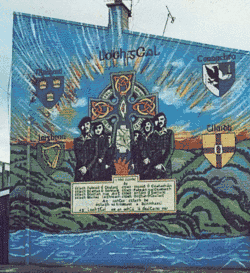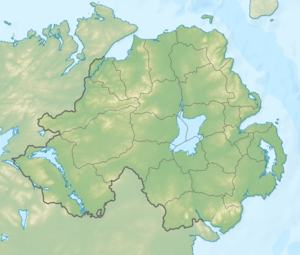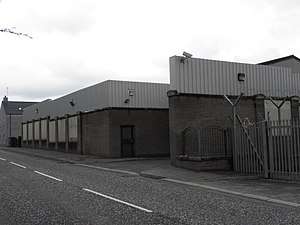Loughgall ambush
| Loughgall ambush | |||||||
|---|---|---|---|---|---|---|---|
| Part of The Troubles and Operation Banner | |||||||
 Mural commemorating the IRA members killed in the ambush | |||||||
| |||||||
| Belligerents | |||||||
|
| |||||||
| Commanders and leaders | |||||||
| Patrick Joseph Kelly † | Soldier A[1] | ||||||
| Strength | |||||||
|
8 in attacking unit[2] 4 in support[3] |
24 SAS soldiers[1] 3 local RUC officers[1][4] | ||||||
| Casualties and losses | |||||||
| 8 killed |
3 soldiers wounded[1] 2 constables wounded | ||||||
| 1 civilian killed, 1 wounded, and 1 detained by SAS[1] | |||||||
 Location within Northern Ireland | |||||||
The Loughgall Ambush took place on 8 May 1987 at the village of Loughgall, County Armagh, Northern Ireland. An eight-man unit of the Provisional Irish Republican Army (IRA) launched an attack on the Royal Ulster Constabulary (RUC) station in the village. Having driven a stolen digger with a bomb placed in its bucket through the perimeter fence, they attacked the building with automatic rifles, the bomb exploding, badly damaging the police station. Soldiers from the British Army's Special Air Service (SAS), who had been lying in wait at the scene, then returned fire both from within the station and from concealed positions around it in a pre-planned and co-ordinated ambush, killing all of the IRA attackers,[1] two of whom were subsequently found in the police investigation of the incident to have been unarmed when they were killed.[1][5]
An innocent civilian was also killed by the SAS engaging unit after unwittingly driving into the midst of the melee, and being mistakenly identified by it as part of the IRA's attacking force.[1]
The joint British Army/Police operation was codenamed Operation Judy.[6][7] It was the IRA's biggest loss of life in a single incident during The Troubles.[8] In 2015, it was announced that a fresh inquest was to be held.[9]
Background and preparations
The IRA's East Tyrone Brigade was active mainly in eastern County Tyrone and neighbouring parts of County Armagh. By the mid-1980s it had become one of the IRA's most aggressive formations. Members of the unit, such as Jim Lynagh and Pádraig McKearney, advocated a strategy of destroying bases and preventing them being rebuilt or repaired in an attempt to "deny ground" to British forces.[10][11] In 1985, Patrick Joseph Kelly became its commander and began implementing the strategy. In 1985 and 1986, it carried out two attacks on Royal Ulster Constabulary stations.[12] The first was an attack on the RUC barracks in Ballygawley on 7 December 1985, in which two police officers were shot dead. The second was an attack on an RUC station at The Birches on 11 August 1986. In both attacks, the police stations were raked with machine-gun fire and then severely damaged with homemade bombs. In the attack at The Birches, they had breached the base's perimeter fence with a digger that had a bomb in its bucket.[11] It was planned to use the same tactic in an attack on the lightly-manned Loughgall Royal Ulster Constabulary station.[11][13]
The British security forces however had received detailed intelligence information about the IRA's plans.[6] It is believed that this was obtained by RUC Special Branch and the British Army's Special Reconnaissance Unit (SRU).[11] It has been alleged that the security forces had a double agent inside the IRA unit, and that he was killed by the SAS in the ambush.[14] Other sources claim that the security forces had instead learned of the ambush through other surveillance methods.[15] In his book, Terrorism: Inside A World Phenomenon, Barry Davies states that the date and time of the attack was eventually confirmed by a telephone tap.[16] According to historian and former Professor of Politics at Queen's University Belfast Richard English, information of the attack had not come from within the unit. Though Tony Gormely was known as a well-paid Special Branch informant.[17]
Three local RUC officers worked at the station; which was only open part-time in twice daily intervals of two hours (09:00 AM to 11:00 AM, and 05:00 PM to 07:00 PM). One of the officers was to carry on the normal running of the station assisted by the other two.[4][1] Whilst six SAS soldiers in plain clothes, including the commander, were positioned inside.[1] Another eighteen SAS soldiers in uniform were hidden in wooded areas in five locations around the station.[1]
The IRA's attack involved two teams. One team would drive a digger with a bomb in its bucket through the base's perimeter fence and light the fuse. At the same time, another team would arrive in a van and open fire on the base,[3] with the aim of killing the three police officers as they came off duty.[18] Both teams would then leave the area in the van.[3] To avoid security checkpoints, the bomb was ferried by boat across Lough Neagh, from Ardboe to Maghery.[19] The van and digger that would be used were hijacked in the hours leading up to the attack.[3] The van, a blue Toyota HiAce, was stolen by masked men from a business in Dungannon. At about the same time, the unit's commander James Lynagh was spotted in the town, suggesting the van might be used in the attack.[16] The digger (a backhoe loader) was taken from a farm at Lislasly Road, about two miles west of Loughgall. Two IRA members stayed at the farm to stop the owners raising the alarm. Declan Arthurs drove the digger, while two others drove ahead of him in a scout car. The rest of the unit travelled in the van from another location, presumably also with a scout car.[3] When a covert observation post monitoring the digger reported that it was being moved, the SAS took up its positions.[16]
Ambush
The IRA unit arrived in Loughgall from the north-east shortly after 7PM.[3] when the station was scheduled to close for the night. All were armed, masked with balaclavas, and wearing boilersuits, surgical gloves and socks over their footwear with the intent of limiting forensic evidence of their presence at the scene. Some of the attackers were also wearing bullet-proof vests.[3] The digger drove past the police station, turned around and drove back again with the Toyota van carrying the main IRA assault party doing the same, in anticipation of the lightly-manned station's staff coming out of the building around that time to go home, thereby presenting themselves as more vulnerable targets.[20] Not seeing any activity in the station in their two slow passes of it, members of the IRA unit felt that something was amiss,[20] and debated whether to continue, but decided to go ahead with the attack.[18] Tony Gormley and Gerard O'Callaghan got out of the van and joined Declan Arthurs on the digger, according to journalist Peter Taylor, "literally riding shotgun", with weapons in one hand and a lighter in the other.[20] At about 7:15 Arthurs drove the digger towards the station.[3] In the front bucket was 200–400 lb[19] of semtex inside an oil drum, partially hidden by rubble and wired to two 40-second fuses.[16] The other five members of the unit followed in the van with Eugene Kelly driving, unit commander Patrick Kelly in the passenger seat whilst in the rear were Lynagh, Pádraig McKearney, and Seamus Donnelly.[20] The digger crashed through the light security fence and the fuses were lit. The van stopped a short distance ahead and — according to the British security forces — three of the team jumped out and opened fired at the police station with automatic weapons.[6] Author Raymond Murray, however, disputes this.[3] According to Taylor, and co-corroborated by the ECHR report, Patrick Kelly jumped from the passenger seat and, followed by others, immediately opened fire on the building, either to encourage the rest to resolve the dispute about going ahead with the attack, or possibly because this was the way previous attacks had begun.[20] At the same time, the bomb detonated, the blast destroying the digger and badly damaging the building, injuring three members of the security forces within.[21]
Within seconds the SAS opened fire on the IRA attackers from the station and from hidden positions outside with M16 and H&K G3 rifles and two L7A2 general-purpose machine guns.[18] 600 spent British cartridge cases from the scene were recovered, with approximately 125 bullet holes in the bodywork of the van.[1] 78 spent cartridges cases were recovered that were fired from IRA weapons.[1] All eight IRA members were killed in the hail of gunfire; all had multiple wounds to their bodies, including their heads.[3][22] Declan Arthurs was shot in a lane-way opposite Loughgall Football Club premises, without a firearm in the direct vicinity, holding a cigarette lighter closed in his right hand.[5][1] It has been alleged by Tim Pat Coogan that three of the wounded IRA members were shot dead as they lay on the ground after surrendering.[23] Three other IRA members in the scout cars escaped from the scene, managing to pass through British Army and Royal Ulster Constabulary check-points set up in the vicinity immediately after the ambush had been sprung.[3][18]
Two innocent civilians travelling in a car which happened to drive into the scene of the ambush whilst it was underway were also opened fire upon by the British forces. The two brothers, Anthony and Oliver Hughes, were driving home in a white Citroen GS Special car after repairing a lorry with Oliver wearing overalls similar in appearance to those being worn by the IRA unit.[5] About 130 yards from the police station, British soldiers opened fire on their car from behind, killing Anthony (driving) and badly wounding Oliver.[3] The Citroen had approximately 34 bullet holes.[1] The villagers had not been told of the operation and no attempt had been made to evacuate anyone or to seal off the ambush zone, as this might have alerted the IRA to the ambush's presence.[7] Anthony's widow was later compensated by the British Government for the death of her husband.[3][24]
The security forces recovered eight IRA firearms from the scene: three H&K G3 rifles, one FN FAL rifle, two FN FNC rifles, a Franchi SPAS-12T shotgun and a Ruger Security-Six revolver. The Royal Ulster Constabulary subsequently linked the weapons to seven known murders and twelve attempted murders in the Mid-Ulster region.[2] The Ruger had been stolen from Reserve RUC officer William Clement, killed two years earlier in the attack on Ballygawley police station by the IRA.[25] It was found that another of the guns had been used in the murder of Harold Henry, a builder who was employed by the British Army and Royal Ulster Constabulary in facilities construction in Northern Ireland.[26]

Aftermath
The East Tyrone Brigade continued to be active until the last Provisional IRA ceasefire ten years later. SAS operations against the IRA also continued. The IRA set out to find the informer it believed to be among them, although it has been suggested that the informer, if there ever was one, had been killed in the ambush.[14] The Loughgall police station was attacked again on 5 September 1990, when the blast from a van bomb badly damaged it, wounding in the process seven constables.[27][27][28]
The IRA unit destroyed in the ambush became known as the "Loughgall Martyrs" among IRA supporters.[29] The men's relatives considered their deaths to be part of a deliberate shoot-to-kill policy by the security forces in the province. Thousands of people attended their funerals, the biggest republican funerals in Northern Ireland since those of the IRA hunger strikers of 1981.[30] Gerry Adams, in his graveside oration, gave a speech stating the British Government understood that it could buy off the government of the Republic of Ireland, which he described as the "shoneen clan" (pro-British), but added "it does not understand the Jim Lynaghs, the Pádraig McKearneys or the Séamus McElwaines. It thinks it can defeat them. It never will."[31]
Shortly after the ambush the Provisional IRA released a statement saying: "volunteers who shot their way out of the ambush and escaped saw other volunteers being shot on the ground after being captured".[32]
In 2001 the European Court of Human Rights ruled that ten IRA men, including the eight killed at Loughgall, had their human rights violated by the failure of the British Government to conduct a proper investigation into their deaths.[22] The court did not make any finding that these deaths amounted to unlawful killing.[33] In December 2011, Northern Ireland's Historical Enquiries Team found that not only did the IRA team fire first but that they could not have been safely arrested. They concluded that the British Army was justified in opening fire.[34]
Loughgall police station was re-built and was in use until its administrative closure in August 2009.[35] In April 2011 it was sold for private development.[36]
Songs
Loughgall Ambush is the name of a republican ballad specifically about the attack, recorded by Charlie and the Bhoys amongst others.[37]
See also
References
- 1 2 3 4 5 6 7 8 9 10 11 12 13 14 15 Case of Kelly and Others v. The United Kingdom [2001] ECHR 328, [2001] ECHR 328, [2001] Inquest LR 125 (4 May 2001), European Court of Human Rights
- 1 2 O'Brien, Brendan (1995). The Long War: The IRA and Sinn Féin. p. 141. ISBN 0-8156-0319-3.
- 1 2 3 4 5 6 7 8 9 10 11 12 13 Murray, Raymond (1990). The SAS in Ireland. Mercier Press, pp. 380–383. ISBN 0-85342-938-3.
- 1 2 Matchett, William (14 November 2016). "LOUGHGALL: How the SAS wiped out 'invincible' IRA unit in just 10 minutes". Belfast News Letter. Retrieved 29 June 2017.
- 1 2 3 "Loughgall — a Search for the Truth". Pat Finucane Centre. Loughgall Truth & Justice Campaign. Retrieved 30 June 2017.
- 1 2 3 Brown, Andrew. The Difficult War: Perspectives on Insurgency and Special Operations Forces. Dundurn, 2009. pp.132–133
- 1 2 MacKenzie, Alastair. Special Force: The Untold Story of 22nd Special Air Service Regiment (SAS). p.319
- ↑ "Ten cases of special forces in action". BBC News, 5 May 2011.
- ↑ Moriarty, Gerry (23 September 2015). "New inquests into deaths of 9 in SAS ambush at Loughgall". The Irish Times. Retrieved 29 June 2017.
- ↑ McDonald, Henry (29 September 2002). "True tale of IRA 'martyrs' revealed". London: The Guardian. Retrieved 19 September 2007.
- 1 2 3 4 Taylor, Peter. "Loughgall: playing it rough". Daily Mail, 8 May 2001.
- ↑ Big Boys' Rules, Mark Urban, Faber and Faber (1992), p. 224, ISBN 0-571-16112-X.
- ↑ Big Boys' Rules, p. 227.
- 1 2 Taylor, Peter (1997). Provos – The IRA & Sinn Féin. Bloomsbury Publishing. p. 276. ISBN 0-7475-3818-2.
- ↑ Holland, Jack (1999). Hope against History. Henry Holt. p. 143. ISBN 0-8050-6087-1.
- 1 2 3 4 davies, Barry (2005). Terrorism : inside a world phenomenon ([New ed.] ed.). London: Virgin Books. p. 203. ISBN 0753510766.
- ↑ English, Richard, Armed Struggle, the History of the IRA, ISBN 978-0-19-517753-4 Page 254
- 1 2 3 4 Young, Connla. "IRA man tells the inside story of the Loughgall attack and the SAS ambush". Irish News. 8 May 2017. Retrieved 8 May 2017.
- 1 2 Young, Connla. "Loughgall bomb was transported by boat". Irish News. 8 May 2017. Retrieved 8 May 2017.
- 1 2 3 4 5 Taylor, Peter (1998). Provos : the IRA and Sinn Fein (Rev. and updated. ed.). London: Bloomsbury. p. 273. ISBN 9780747538189.
- ↑ Ellison, Graham and Smyth, Jim (2000). The Crowned Harp: Policing Northern Ireland. Contemporary Irish Studies. Pluto Press, p. 122. ISBN 0-7453-1393-0.
- 1 2 "IRA deaths: The four shootings". BBC. 4 May 2001. Retrieved 11 March 2007.
- ↑ Coogan, Tim Pat (1995). The Troubles: Ireland's Ordeal 1966–1995 and the Search for Peace. Hutchinson. p. 290. ISBN 0-09-179146-4.
- ↑ Taylor, Peter (1997). Provos: The IRA and Sinn Féin. p. 274.
- ↑ Urban, Mark (1992). Big Boys' Rules. Faber and Faber. p. 229. ISBN 0-571-16809-4.
- ↑ Toolis, Kevin (1995). Rebel Hearts: Journeys within the IRA's soul. Picador, p. 65. ISBN 0-330-34243-6.
- 1 2 Reuters, 5 September 1990
- ↑ CAIN – Listing of Programmes for the Year: 1990-BBC news, 5 September 1990
- ↑ Bean, Kevin (2008). The New Politics of Sinn Féin. Liverpool University Press, p. 1. ISBN 1-84631-144-6.
- ↑ Secret History of the IRA, Ed Moloney, 2002, p. 324.
- ↑ Secret History of the IRA, Ed Moloney, 2002, p. 325.
- ↑ PIRA Propaganda:The Construction of Legitimacy, by Joanne Wright
- ↑ "UK condemned over IRA deaths". BBC. 4 May 2001. Retrieved 28 October 2008.
- ↑ "Shot IRA unit 'fired first at SAS'". Belfast Telegraph. 2 December 2011.
- ↑ Property Sold by the PSNI in the Last Ten Years Archived 17 December 2011 at the Wayback Machine.
- ↑ Provo Massacre PSNI Station Sold; Scene of 11 killings set to be used for housing The Mirror, 27 April 2011.
- ↑ Song details